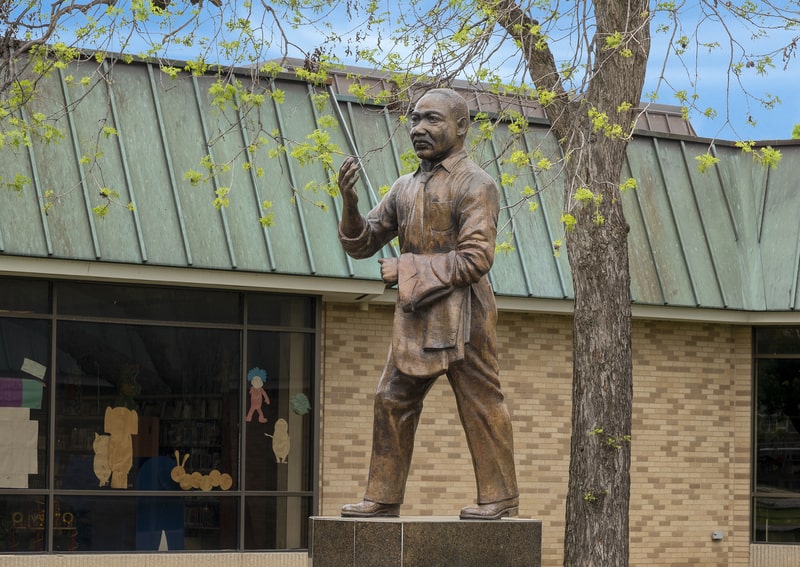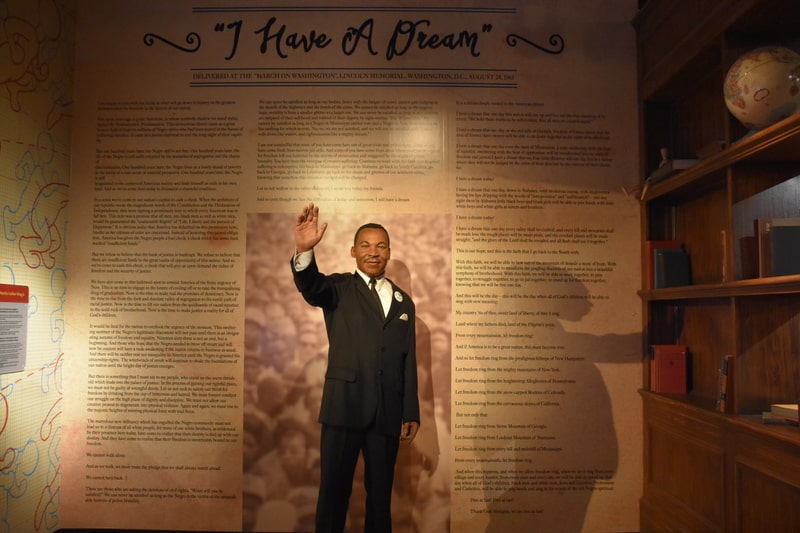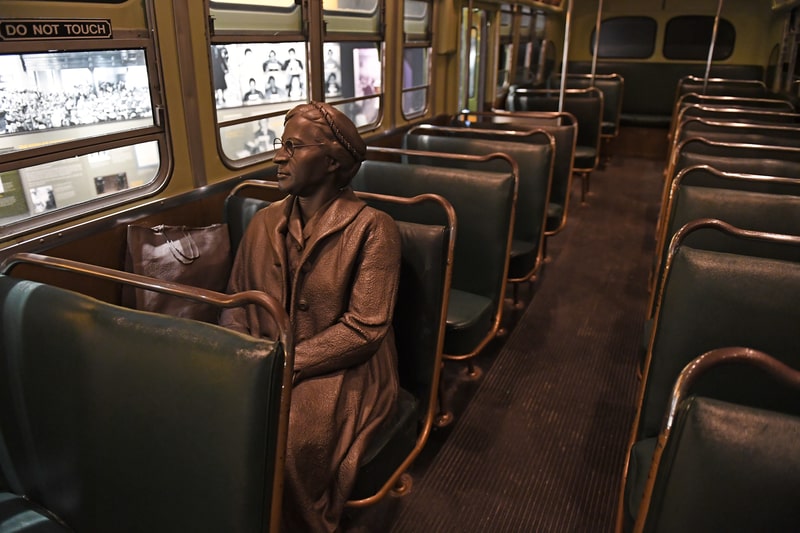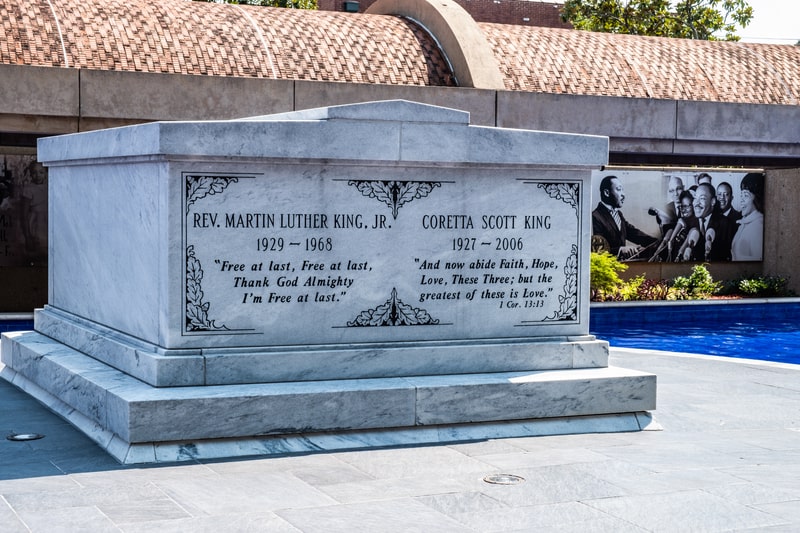Last updated on April 4th, 2023
MLK was the most prominent civil rights leader of the 1960s. He used his platform as a church minister to dismantle the oppressive system despite threats to his life and liberty. These efforts resulted in landmark legislation and broad support, but they came at a cost. He endured bomb threats, blackmail, deadly attacks, and multiple arrests. His unwavering spirit touched the lives of millions in the United States and around the world. Read on to discover 60 interesting facts about Martin Luther King Jr.
Early Life and Family
1. The Birth of an Icon
The familiar name came later. On January 15, 1929, he was born as Michael King Jr. on the second floor of his grandparent’s house in Atlanta, Georgia. Congress designated it as a National Historic Site in 1980.
2. The Father Blazes the Trail
Michael King Sr. was the son of sharecroppers in Georgia. He became a Baptist pastor after drawing inspiration from ministers who stood up for racial inequality.
3. Mother and Music
Alberta Williams King was the daughter of a preacher. She worked as a teacher, organist, choir director, and civil rights advocate. It was through her that little Michael developed a love for music.
4. Bible Study Sessions
As children, he and his siblings read the Bible out loud in front of their dad. Their grandmother would also tell them engaging Bible stories to instill core lessons in their young minds.
5. Corporal Punishment
As was common in those days, his father would use a whip to discipline the children. Michael was peculiar. He would stand with tears in his eyes but never cry audibly.
6. A New Name
In 1934, his father went to Berlin for an international Baptist meeting. King Sr. became fascinated with Martin Luther, the 16th-century theologian, and decided to use the name for himself and his son upon his return.
7. Baptists vs. Nazis
The Berlin trip allowed King Sr. to see the rise of the Nazis in Germany. The Baptist World Alliance condemned the racial oppression of Jews and people of color as violations of the law of God.
8. Discrimination Hits Close to Home
Young MLK had a white friend in their neighborhood, but the boys drifted apart at age six due to racial segregation. They went to different schools and could no longer play together. His parents had to explain the history of black slavery quite early.
9. A Master of Words
MLK excelled in history and English. He regularly browsed the dictionary to expand his vocabulary. In neighborhood clashes, he used his knowledge to confuse people and stop the fights.
10. MLK and Music
Under his mother’s influence, he took piano and violin lessons. He also enjoyed the opera. As a choir member, he sang in the Atlanta premiere of “Gone with the Wind,” wearing a slave costume for a white audience.

Coming of Age
11. A Young Manager
MLK works hard. At only 13 years old, he became the assistant manager at a newspaper delivery station. They served the Atlanta Journal to their customers.
12. An All-Black High School
Atlanta did not have a high school for blacks in the 1920s. His grandfather was among those who petitioned the local board to open one, resulting in Booker T. Washington High School in 1924. MLK studied there in 1942 and had a B+ average.
13. A Budding Orator
As a teenager, he developed a baritone voice and exceptional speaking ability. These made him a good fit for the debate team. In 1944, he won an oratorical contest for a speech about the continuing slavery of Black America.
14. A Bus Stand-off
The high wore off fast. During the ride home from the contest, the bus driver hurled abusive words at MLK. He and his teacher had to stand up and give their seats to whites, rousing his anger.
15. Sibling Support
MLK may know plenty of words, but he struggled with grammar and spelling. His sister, Christine, helped him out. In turn, he tutored her in math.
16. A Penchant for Fashion
His friends called teenage MLK “Tweedie” because of his clothing preferences. He liked dressing up in tweed suits and leather shoes to impress the girls.
17. Starting College
World War II made enrollments plummet. Morehouse College began accepting high school juniors, and MLK went at age 15 to study sociology. It is also the alma mater of his father and grandfather.
18. An Eye-opening Summer Job
To pay for tuition, MLK and his friends worked on a tobacco farm in Connecticut – his first experience living in an integrated state. Despite the backbreaking work, he loved it there because shops, restaurants, and churches did not discriminate against them.
19. Graduate Education
In 1948, MLK decided to serve through the church. He enrolled in the Crozer Theological Seminary and became the student body president. Later, he pursued doctoral studies at Boston University and took philosophy classes at Harvard.
20. Marriage and Family
MLK met his future wife in Boston: Coretta Scott, a student-activist at the New England Conservatory of Music. They had four children, Yolanda, Dexter, Bernice, and MLK III.

Activism through the Years
21. The 1955 Montgomery Bus Boycott
MLK was a new pastor when police arrested Rosa Parks. He led a tense boycott that made him the target of an arrest and a house bombing. It led to a court decision banning racial segregation in public buses.
22. The 1957 Southern Christian Leadership Conference
Civil rights activists created the SCLC to harness the power of black churches for reform. They organized communities and conducted nonviolent protests. MLK led the group until his death.
23. The 1960 Atlanta Sit-ins
Students in his hometown were trying to desegregate businesses through organized sit-ins. MLK participated in one of these, but authorities arrested him and handed him a harsh sentence. Presidential candidate John F. Kennedy intervened for his release.
24. The 1961 Albany Movement
In Albany, thousands of residents joined a peaceful protest against segregation. MLK visited to give counsel, but authorities detained him after a mass arrest. The evangelist Billy Graham bailed him out.
25. The 1963 March to Washington
Civil rights groups organized a march to the capital to demand vital legislation. Despite infighting, it was a resounding success with over 250,000 participants. MLK delivered his famous “I Have a Dream” speech at this event.

26. The 1964 Scripto Boycott
In the mid-1900s, Scripto was the largest manufacturer of writing instruments. MLK helped the factory workers get nationwide support for their strike. He also negotiated a new contract for the union.
27. The 1965 Selma to Montgomery Marches
Voting rights advocates attempted a peaceful march to the state capital of Alabama, but the police turned violent against them. Footage of Bloody Sunday aroused public outrage. MLK supported the cause by organizing more marches for voting reform.
28. The 1966 Chicago Freedom Movement
Turning to the north, MLK tackled the problem of housing discrimination against black families. Protests became dangerous, with bottles and verbal abuse hurled at participants. King was hit by a brick but continued to lead.
29. The 1967 Opposition to Vietnam War
He thought about it for a long time. In 1967, MLK publicly denounced the Vietnam War as an extension of his nonviolent stance. He lost the support of powerful white allies, such as President Johnson and big publishers, but he did not waiver.

30. The 1968 Memphis Strike and Assassination
Black sanitary workers in Tennessee went on strike for higher wages. MLK joined them despite a bomb threat that delayed his flight. At the Lorraine Motel, an assassin fatally shot him on the second-floor balcony.
The Impact of Martin Luther King Jr.
31. Race Riots after the Assassination
An emergency chest surgery could not save him. The assassination triggered race riots in dozens of cities, including Chicago, Kansas, Baltimore, and Louisville.
32. Demonstrations in the Capital
Thousands flocked to the National Mall in downtown Washington. They established a temporary camp and stayed there for six weeks to air their grievances. It was known as Resurrection City.
33. National Day of Mourning
President Lyndon Johnson declared April 7 a National Day of Mourning for MLK. He appealed for calm during the tense period by calling politicians and civil rights leaders.
34. Funeral and Procession
Around 100,000 joined the last rites on April 9, including VP Humphrey, Sen. Robert Kennedy, NY Gov. Nelson Rockefeller, Stevie Wonder, Aretha Franklin, Diana Ross, Wilt Chamberlain, Bill Russell, Jackie Robinson, Sidney Poitier, Bill Cosby, Marlon Brando, and Paul Newman.
35. The Civil Rights Act of 1964
MLK left a lasting legacy. He pushed for the passage of a law that forbids racial segregation in public accommodations and schools across the country. It also made employment discrimination illegal.
36. The Voting Rights Act of 1965
The civil rights movement campaigned for federal legislation that protects the voting rights of racial minorities. It outlawed literacy tests and other tools to disenfranchise voters.
37. The Fair Housing Act of 1968
Days after the assassination, Congress passed a law that prohibited housing discrimination based on race, religion, and national origin — one of MLK’s advocacies during his latter years.
38. Influence on South Africa
MLK left a mark on the South African activists who fought against apartheid, including Albert Lutuli, leader of the African National Congress and winner of the Nobel Peace Prize.
39. Influence on Northern Ireland
Irish politician John Hume looked up to MLK and cited his influence in crafting the Good Friday Agreement in 1998 between Britain and Ireland. It ended much of the conflict in the region that started in the 1960s.
40. Influence on Barack Obama
As a young community organizer in Chicago, Obama studied the life of MLK to understand the civil rights movement. It also deepened his appreciation for the church and spurred his spiritual development.
Achievements and Awards
41. The 1964 Nobel Peace Prize
MLK became the youngest winner of the Nobel Prize at 35. In his acceptance speech, King hailed Mohandas Gandhi, Henry David Thoreau, Reinhold Niebuhr, Paul Tillich, and Walter Rauschenbusch as his influences for nonviolent activism.
42. The 1977 Presidential Medal of Freedom
It is the highest award a civilian can receive in the United States. The president gives it to recognize exceptional contributions to the national interest. In 1977, President Jimmy Carter posthumously conferred it to MLK and called him the conscience of his generation.

43. The 2004 Congressional Gold Medal
Congress awards gold medals for distinguished achievements. George Washington was the first recipient in 1776. MLK and his wife, Coretta Scott King, also received medals in 2004 for their roles in the civil rights movement.
44. Martin Luther King Day
The United States celebrates his birth with a federal holiday every third Monday of January. It can fall between January 15 and 21, depending on the calendar year.
45. Places Honoring MLK
King County in Washington State took its name from a slaveowner, William Rufus King. In 1986, the council changed the namesake to Martin Luther King Jr. to honor the civil rights leader. Hundreds of streets around the country also bear his name.
46. The Martin Luther King Jr. Memorial
In 2011, a national memorial opened in West Potomac Park in Washington, DC. It contains a granite statue of MLK called Stone of Hope — a line taken from his famous speech, “I Have a Dream.”
47. MLK Statue in Westminster Abbey
Westminster Abbey is an important religious site for British monarchs. In 1998, the church honored 20th-century Christian martyrs with statues above the Great West Door. Martin Luther King Jr. was among them.
. . . continue reading on the next page
